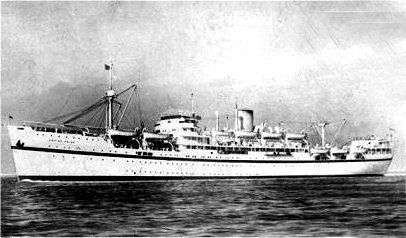
H. T. Empire Pride
At first sight the East was disappointing. At Port Said the flies and the importunate salesmen were equally irritating. The Red Sea was, to us, insufferably hot, and Aden an unexciting town at the foot of bare inhospitable cliffs. We passed Ceylon with no more than longing glance at the distant palms and the breaking surf. But Singapore was different. in the cool of the early morning we passed between the many small green islands, and after three and a half weeks at sea we were very pleased to see the masts of Singapore harbour.
We arrived on June 18th. As we came near to the dockside we could see a small crowd waiting to meet us. The Band of The Devonshire Regiment was on the quay, and our own Band was playing on the poop deck of the ship. The civil authorities thought that our arrival might possibly provoke some form of Communist demonstration, so, as a precaution, “B” Company was disembarked straight away and took up positions in the dock area in order to be able to protect the main disembarkation.
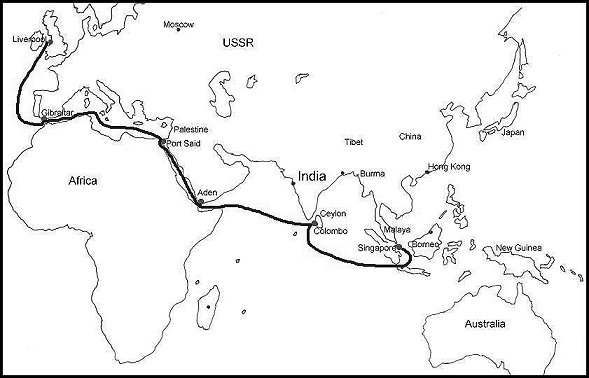
Route taken by the 1st Battalion to Singapore
The disembarkation was completed smoothly with no sign of the threatened demonstrators, and we were soon aboard the three-tonners which were to take us to our camp at Nee Soon. We noticed that the vehicles had wire mesh over their canvas canopies and windows, as a precaution against grenade throwing. Our convoy moved through the spacious suburbs of Singapore. The large houses and bungalows, many in extensive grounds, were well shaded by trees and overhanging roofs, and here and there a native gardener was leisurely scything a large expanse of lawn. Once out of the town the scene was very different; there were few trees to hide the glare of the sun and by the roadside were small wooden huts where the poorer Chinese lived in what appeared to be very squalid conditions. We arrived at the Transit and Training Centre, Nee Soon, at about mid-day. It was very hot and there seemed to be no shade anywhere in the camp. For the first time we were experiencing the enervating humidity which is so characteristic of the Malayan climate.
The Battalion was in tents, and the lines were packed tight on the slope of a bare hill. Everyone was extremely busy. While the transport, stores and equipment were being collected, the rifle companies were starting their jungle training (At this time " A” Company was still in suspension and had not re-formed). Many of the advance party had already been to the F.A.R.E.L.F. Training Centre at Tampoi in South Johore, and the majority of the remaining officers and N.C.O.‘s from the rifle companies went on this very interesting and instructive three-week course in jungle warfare. In the meantime we had sent a small contact team to Tapah (in the State of Perak), where we were expecting to take over from the 1st Battalion The Coldstream Guards.
In mid-July a large-scale operation was mounted by the 2nd/10th Gurkha Rifles in Southern Johore, and “B” Company, although officially still in training, were placed under command. The Company (commanded by Major A. F. J. G. Jackson) was ordered to occupy an area some miles up the River Tinggi, North of the town of Kota Tinggi. There was a small Chinese settlement, which had rarely been visited by Security Forces, and which was believed to be dominated by Communist terrorists. It was hoped that the arrival of the Company would be a surprise and that any terrorists there would be driven into the surrounding jungle, where other troops would be in ambush positions on known tracks.
In the afternoon of July 12th, “B” Company left Nee Soon, and moved in vehicles to Johore Bahru, where a final conference was held with the Gurkhas. This was the first time that the majority of the Company had been on to the mainland and the men were in high spirits, and any terrorists who had tried to ambush the convoy would have had a very poor chance. They arrived at Kota Tinggi in the late afternoon. They were then transferred to three long-boats, which were to take them up the river. Three hours’ steady progress brought them at last right to a small disused rubber plantation, where it was proposed to spend the night. This was the first night that they had spent in the jungle, and it was lucky that there was no rain, as their first ‘bashas” (Temporary shelter) were not very expertly made.
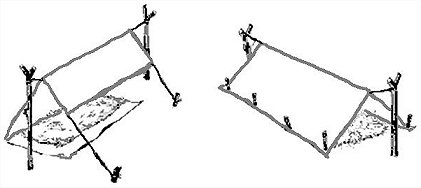
Basha examples
With a waterproof poncho, groundsheet, piece of tarpaulin or plastic sheeting you can construct what is often referred to in the forces as a
"basha".
Very early the next morning, some hours before first light, the Company continued on its way upstream. An all-night watch on the river had ensured that no boats had passed the camp to give warning of the departure from Kota
Tinggi, and it was considered most unlikely that any terrorist couriers could have moved through the jungle from the town in time to warn the Communists in the area of the objective. Only two platoons continued upstream; 4 Platoon was left to work its way overland and search for tracks.
The main body of the Company reached the settlement with complete surprise. It was an area of some two square miles of cultivated rubber, with two “kongsis” (Communal Chinese dwellings) and a few isolated huts. The platoons were deployed quickly, the rubber was searched and the population rounded up. The men were sent back by boat to be interrogated by the Police, while the women and children were confined in the larger
kongsi; they were guarded to ensure that none should escape and give warning of the presence of Security Forces. No uniformed terrorists were seen, but it was obvious from the alarm and hostility of the population that this was a terrorist area. 6 Platoon was divided into standing patrols, which were placed on tracks in the hope of ambushing terrorists who might approach the settlement. Meanwhile the area was searched for arms and food dumps. There were two or three skirmishes with terrorists, but unluckily they were only fleeting glimpses of a few seconds, and the only tangible results were some blood trails. There could be no doubt that the Company had completely surprised and bewildered the local terrorist
organisation. But unfortunately, at this stage, the Company had not acquired sufficient experience of jungle technique to take the best advantage of their opportunities. However, it was discovered some months later, from captured documents, that one terrorist at least died from wounds sustained in one of those brief contacts.
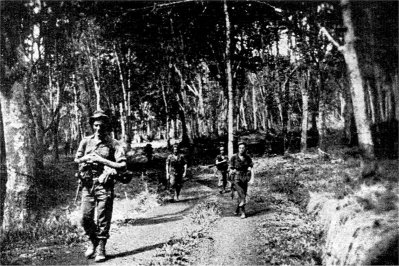
7 Section of 6 Platoon “B” Company - Cpl. Cawley leading
Very late that evening the remaining section arrived at the edge of the rubber plantation and began to work along it. They had only gone fifty yards when they found a track, which showed signs of recent use where it crossed a swamp. It was then that the platoon commander wished that he had his whole platoon. With bayonets fixed the section moved cautiously along the track, which pushed its way, with frequent false trails, through the "belukar.” (very dense secondary undergrowth). There was no doubt that this was a track frequently used by terrorists. Suddenly, the leading scout stopped and crossed his hands above his head—the signal for a terrorist hut. The platoon commander decided to stop and ambush the hut. Very carefully, to avoid leaving any clues, the area was reconnoitred. It was found that the hut was at the junction of two tracks and contained a sleeping bench and some cooking utensils. It was obviously a staying post for terrorist couriers. The section had advanced along the first track, which continued beyond the hut. The second track came from the West over the swamp and crossed a small stream just before its junction with the first track, which at this point dipped down to the very edge of the stream, probably to provide a water point.
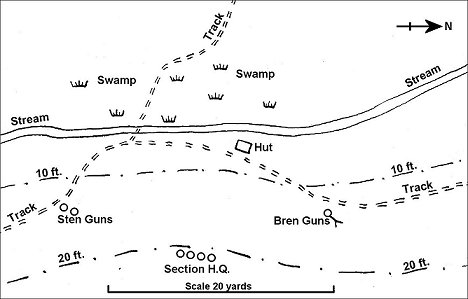
Ambush of terrorist hut
Just before last light everything was ready and all the section were satisfied with their position except the section commander, who complained of a peculiar smell around the small rise in the ground, which was his fire position. The cause of the mysterious smell was to have a startling explanation later in the operation, but meanwhile the platoon commander assured the corporal that the jungle was full of strange smells, after which he settled down for the night.
Sentries were detailed off, although even those off duty had little sleep that night. But nothing happened, and it was a disappointed section that cooked its tinned beans and bacon on the following morning. There was no contact with the Company base by wireless and the platoon commander decided to remain in the position for another day before going back into the rubber to re-join Company headquarters.
It was just beginning to look like a wasted morning when, about mid-day, the section commander came across to the platoon commander and said, “They have arrived.” The platoon commander, thinking that the two missing sections had arrived, asked where the platoon serjeant was. “No, sir,” replied the corporal, “the bandits are here.” The corporal had seen two terrorists enter the ambush from his end and had waited, quite correctly, for the bren gun at the far end to spring the ambush. When the bren gun did not open fire, he thought that the terrorists had stopped at the hut, as he could not see down the track for more than a few yards. So, quietly, the platoon commander and the section commander moved down to the bren gunner to find out what had happened. It transpired that the bren gunner had seen two terrorists walk straight through the ambush and down the track past him. But before the investigation could proceed further, they heard the snap of a dead twig and caught a glimpse of a hat with a red star. The two terrorists had turned about and were now very cautiously moving back towards the hut. Although they were only a few feet from the track, the thickness of the jungle undergrowth hid the party round the bren gun from the inquisitive eyes of the terrorists. They walked slowly on until, attracted by some slight nervous sound, the leading Chinese stopped, looked round, and came face to face with the platoon commander. There was a sudden sharp burst of fire and the Battalion had killed its first two terrorists.
The two bodies were approached carefully in case either of the terrorists was still alive. They proved to be dead, and were soon stripped of their arms and equipment. The section moved back out of the jungle into the less awesome rubber to find all at Company headquarters anxious to learn the cause of the firing.
After some further searching and ambushing, the operation was concluded. A patrol of Gurkhas came up the river with the boats, which were to take the Company back. With them they brought police, who were taken to the scene of the action in order to photograph the dead bodies for identification purposes. Having obtained the necessary photographs, it was decided to bury the bodies, and a suitable place seemed to be the sandy soil where the section commander had had his fire position. Digging commenced, and a few inches below the surface was found the decaying body of another terrorist.
The Company embarked once again in the long-boats and sailed down the river to Kota Tinggi; from there they returned to the Battalion at Nee Soon, where they received well earned congratulations on a most successful first operation.
By now the Battalion had been informed that it would not, after all, be going to Tapah in Perak, but would go instead to Sungei Patani in Kedah. On July 15th the Commanding Officer flew with a small party to make a preliminary reconnaissance of the new area, and on the morning of July 25th the Battalion left Singapore Station on the special train, which was to take them on the five hundred mile journey to Sungei Patani.